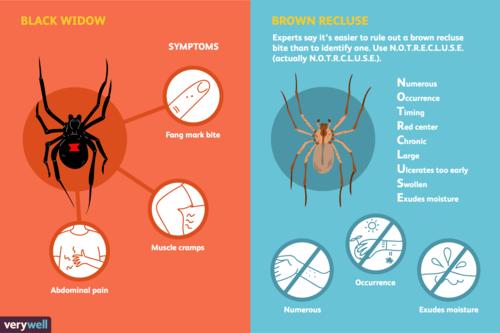
Picture of Spider Bite: A Detailed Look
When encountering a spider bite, it’s crucial to recognize the symptoms and understand the potential risks. A picture of a spider bite can provide a visual reference to help identify the type of spider and the severity of the bite. In this article, we will delve into the various aspects of spider bites, including their appearance, symptoms, and treatment options.
Understanding Spider Bites
Spider bites can range from mild to severe, depending on the type of spider and the individual’s immune response. While most spider bites are harmless, some can be life-threatening. Recognizing the signs and symptoms of a spider bite is essential for prompt and appropriate treatment.

Appearance of Spider Bites
A typical spider bite may appear as a small, red or purple mark on the skin. The bite may be accompanied by a small, raised bump or blister. In some cases, the bite may not be visible, especially if the spider has a small fang or if the bite is on a less visible area of the body.
| Spider Bite Appearance | Description |
|---|---|
| Red or purple mark | Typical bite mark, often accompanied by a bump or blister |
| Small, raised bump | May be present, especially in cases of venom injection |
| Blister | Can occur if venom has caused tissue damage |
| Swelling | May occur around the bite area, indicating an allergic reaction |
Common Symptoms of Spider Bites
Common symptoms of a spider bite include pain, swelling, redness, and itching at the bite site. In some cases, symptoms may appear within minutes or hours after the bite. Here are some of the most common symptoms:
- Pain: The bite may cause immediate pain, which can range from mild to severe.
- Swelling: The area around the bite may swell, sometimes significantly.
- Redness: The bite site may become red and inflamed.
- Itching: Itching may occur around the bite area.
- Wheal: A raised, red bump may form at the bite site.
- Blister: A blister may develop if venom has caused tissue damage.
Identifying the Spider
Identifying the spider responsible for the bite can help determine the potential severity of the bite and the appropriate treatment. Here are some common spiders known to cause bites:
- Black Widow: Characterized by a red hourglass mark on the abdomen. Bites can be severe and may require medical attention.
- Brown Recluse: Known for its dark brown color and violin-shaped marking on the back. Bites can cause severe tissue damage and may require medical attention.
- Spider Bite: A general term for bites from various spider species, some of which may be venomous.
Treatment Options
Most spider bites can be treated at home with basic first aid measures. However, if symptoms are severe or if you suspect a venomous spider bite, it’s essential to seek medical attention promptly. Here are some common treatment options:
- Wash the bite area with soap and water to prevent infection.
- Apply a cold compress to reduce swelling and pain.
- Take over-the-counter pain relievers, such as ibuprofen or acetaminophen, to manage pain and inflammation.
- Keep the bite area elevated to reduce swelling.
- Seek medical attention if symptoms worsen or if you experience difficulty breathing, severe pain, or other life-threatening symptoms.
Prevention Tips
Preventing spider bites involves taking certain precautions, especially in areas where venomous spiders are known to thrive. Here are some tips to help reduce your risk of a spider bite







